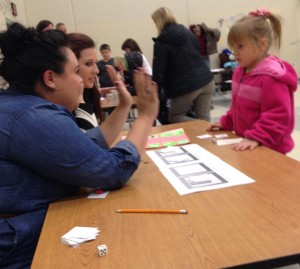Racing Lincolns
Standard:
CCSS.Math.Content.6.EE.B.7 Solve real-world and mathematical problems by writing and solving equations of the form x + p = q and px = q for cases in which p, q and x are all nonnegative rational numbers.
Preview Questions:
1. What is the order of operations?
2. What are the steps to solve an equation in the y=mx+b format if the elements {m, x, and b} are given?
Purpose of Game: The purpose of this game is to help reinforce students understanding of solving equations with letter variables. The students will solve linear equations using the number they rolled on their dice as an x-input and the output will be either a negative or positive whole number.
Objective of Game: The objective of the game is to make it to the end space first!
List of Materials:
One penny for each player
A game board for each group
One dice for each group
A set of flashcards for each group
Scratch paper to solve problems
Rules:
- This game can be played with 2-4 people.
- The set of cards are shuffled and placed in the center of the table.
- Each player chooses a penny as his or her game piece.
- Each player rolls the dice to see who goes first.
- Player 1 chooses a flashcard from the deck and rolls the dice. The player will solve the equation using the number on the dice as the x-input. The y-output will be how many spaces the player moves on the game board.
- If the player lands on a space with a red arrow, the player must move to the space that the red arrow indicates. If the player lands on a regular blue arrow, the player’s token stays on that arrow until their next turn.
- If a player notices that a fellow racer solved an equation incorrectly, the player can challenge their opponent and solve the equation correctly. The player that solves the equation correctly can move their token the correct amount of spaces and the player that answered the question incorrectly does not move their token.
- The next player will do the same, and the players will repeat this process until one player reaches the end point of the board first.
- The first person to reach the end first wins.
Modeling Example:
Teacher: We are about to start a round of Racing Lincolns—in this game each of you will be given a different colored penny as your token, the first penny to reach the end of the board will win. I will play a turn for all of you to show you how to play.
Teacher: First I am going to pull a flashcard to see what equation I will need to solve. I have just pulled a flashcard that reads “y=2x-3”, and I have just rolled my dice and the face reads five. Once I solve the problem I see that my solution is seven, which means that I get to move my penny token to the seventh spot on the game board.
Teacher: If I was playing in a group all of my partners would do the same and we would continue until one of us reaches the end point on the game board.
Teacher: If all of you have your game pieces and understand how to play then you are all set to get into groups of two to four and play the game.
Teacher: May the best Lincoln win!
Adaptation:
1) For older students, the flashcards will be in quadratic form.
2) For younger students, the flashcards will be in the format “3 + ____ = ?” instead of in y=mx+b format. The flashcards would only have a positive output.
Follow-up Questions:
Complete the Racing Lincolns Pit Stop worksheet.
